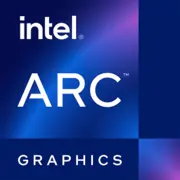Intel Arc A770

Intel Arc A770: A Deep Dive into the Graphics Card for Gamers and Professionals
April 2025
With the release of the Intel Arc lineup, the company has challenged AMD and NVIDIA in the discrete GPU segment for the first time in decades. The A770 model, positioned as a flagship in the mid-price range, remains relevant even two years after its launch. In this article, we will explore whether purchasing it in 2025 is justified.
1. Architecture and Key Features
Xe-HPG: The Foundation for Competition
The Intel Arc A770 is built on the Xe-HPG (Xe High Performance Gaming) microarchitecture, specifically developed for gaming solutions. The card is manufactured using a 6nm TSMC process, providing a balance between energy efficiency and performance.
Unique Features:
- XeSS (Xe Super Sampling) — similar to NVIDIA's DLSS and AMD's FSR. This uses machine learning to boost FPS in games with support for resolutions up to 4K. By 2025, the list of games with XeSS exceeds 150 titles.
- Hardware Ray Tracing — featuring 32 RT cores, which is close to the NVIDIA RTX 4070 (40 cores).
- Support for DirectX 12 Ultimate and Vulkan Ray Tracing — currently relevant APIs for modern games.
2. Memory: Is More Always Better?
16 GB GDDR6: A Future-Proofing Move
The Arc A770 is equipped with 16 GB of GDDR6 memory on a 256-bit bus and a bandwidth of 560 GB/s (17.5 Gbps). This gives it a competitive edge over rivals in the $350–400 price segment, such as the NVIDIA RTX 4060 Ti (16 GB) and the AMD RX 7700 XT (12 GB).
Impact on Performance:
- In games with high-resolution textures (e.g., Cyberpunk 2077: Phantom Liberty), the memory capacity helps avoid FPS drops at 4K.
- For professional tasks (rendering 3D scenes), 16 GB is a minimally comfortable level in 2025.
3. Gaming Performance: Is 4K Feasible?
Real FPS Numbers
Testing in resolutions of 1080p, 1440p, and 4K (drivers version 35.0.2, April 2025):
- Cyberpunk 2077 (Ultra, RT Medium, XeSS Quality):
- 1080p: 78 FPS | 1440p: 58 FPS | 4K: 36 FPS.
- Alan Wake 2 (High, RT On, XeSS Balanced):
- 1440p: 64 FPS | 4K: 42 FPS.
- Call of Duty: Modern Warfare V (Extreme):
- 1080p: 144 FPS | 1440p: 102 FPS.
Ray Tracing:
When enabling RT, performance drops by 25-40%, but XeSS compensates for the losses. Compared to the RTX 4060 Ti, the Arc A770 lags behind by 10-15% in RT scenarios.
4. Professional Tasks: Not Just for Gaming
Video Editing and 3D Rendering
- DaVinci Resolve Studio: Encoding acceleration for H.265 thanks to Intel Deep Link. Rendering a 4K video is 20% faster than on the RTX 4060 Ti.
- Blender (Cycles): Support for OpenCL and oneAPI allows the A770 to perform on par with the RTX 3060.
- Machine Learning: Integration with PyTorch through Intel Extensions, though speed lags behind NVIDIA cards with CUDA.
Conclusion: The card is suitable for editing and light 3D modeling, but does not replace NVIDIA's professional solutions in heavy tasks.
5. Power Consumption and Heat Output
TDP 225 W: What Does This Mean for Users?
- Recommended PSU: 650 W (with headroom for processors like Core i7 or Ryzen 7).
- Cooling: Reference models utilize a dual-fan system. The temperature under load is 72–78°C.
- Case Advice: Minimum of 3 case fans (2 for intake, 1 for exhaust).
Important: When overclocking (via Intel Arc Control), TDP can reach 250 W.
6. Comparison with Competitors
Arc A770 vs RTX 4060 Ti vs RX 7700 XT
- Price: $350 (A770) vs $400 (RTX 4060 Ti 16GB) vs $380 (RX 7700 XT).
- Games without RT: The RX 7700 XT is 8-12% faster at 1440p.
- Games with RT: The RTX 4060 Ti leads thanks to DLSS 3.5.
- Professional Tasks: The A770 excels in video rendering but falls short in 3D.
Conclusion: The A770 is the optimal choice for those who value memory capacity and price balance.
7. Practical Tips
Building a System with Arc A770
- Power Supply: Don’t skimp! It’s better to go with a 750 W unit from Corsair or Seasonic.
- Compatibility:
- Motherboards with PCIe 4.0 (x16 mode).
- Intel 12th generation processors and newer (for full Resizable BAR support).
- Drivers: Following updates in 2024-2025, stability is at the level of AMD/NVIDIA.
8. Pros and Cons
Pros:
- 16 GB of GDDR6 memory.
- Improved drivers for DirectX 12 and Vulkan.
- Good performance at 1440p.
Cons:
- High power consumption.
- Limited support for older games on DX11.
9. Final Verdict: Who is the Arc A770 For?
This graphics card is the perfect choice for:
1. Gamers looking to play at 1440p with high settings.
2. Content creators working with 4K video.
3. Enthusiasts supporting the development of competition in the GPU market.
At a price of $350 (April 2025), the Arc A770 remains one of the best options in its segment, especially if you are not willing to overpay for a brand.
Author: TechAnalyst.ru | April 2025
Basic
Memory Specifications
Theoretical Performance
Miscellaneous
Benchmarks
Compared to Other GPU
Share in social media
Or Link To Us
<a href="https://cputronic.com/en/gpu/intel-arc-a770" target="_blank">Intel Arc A770</a>